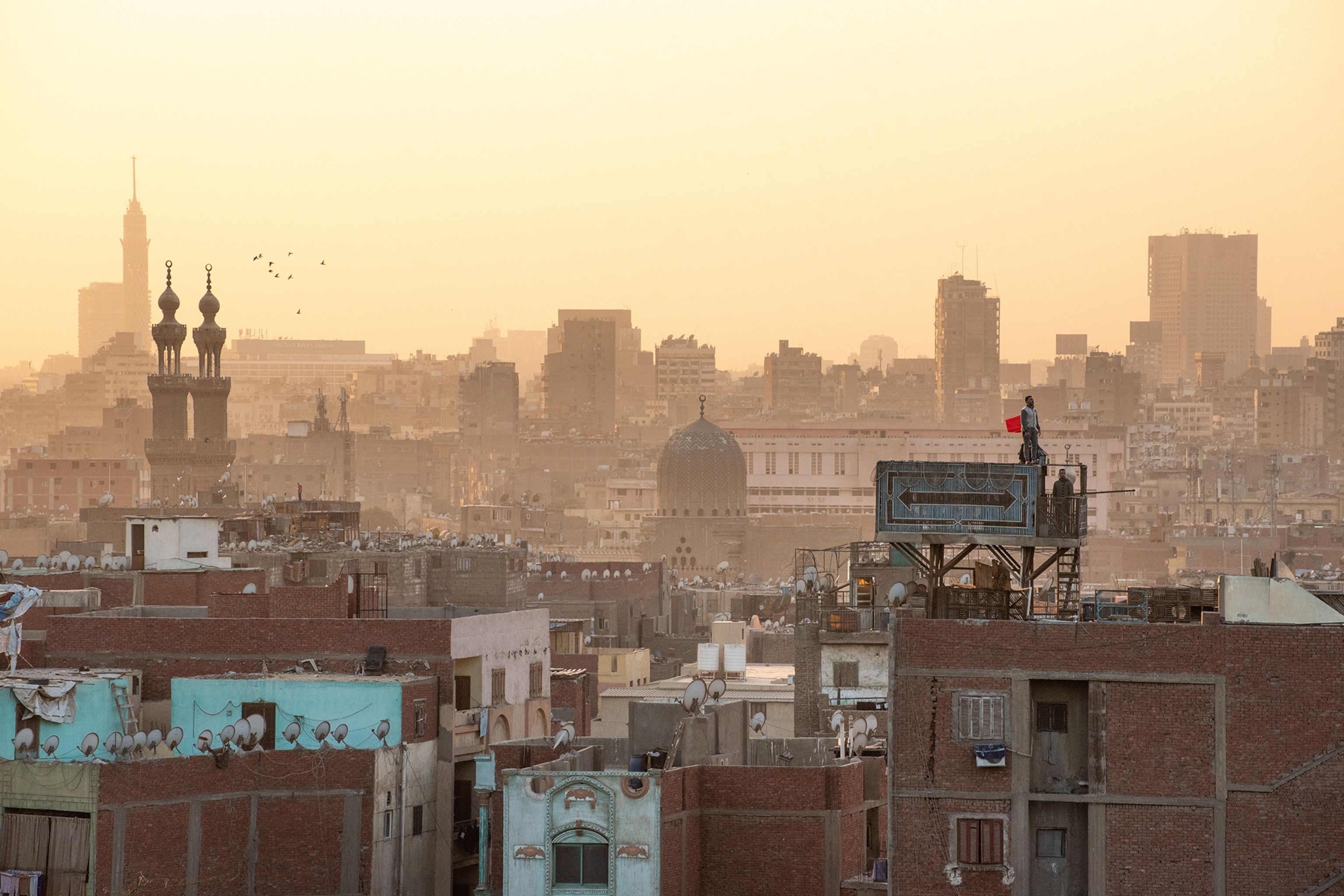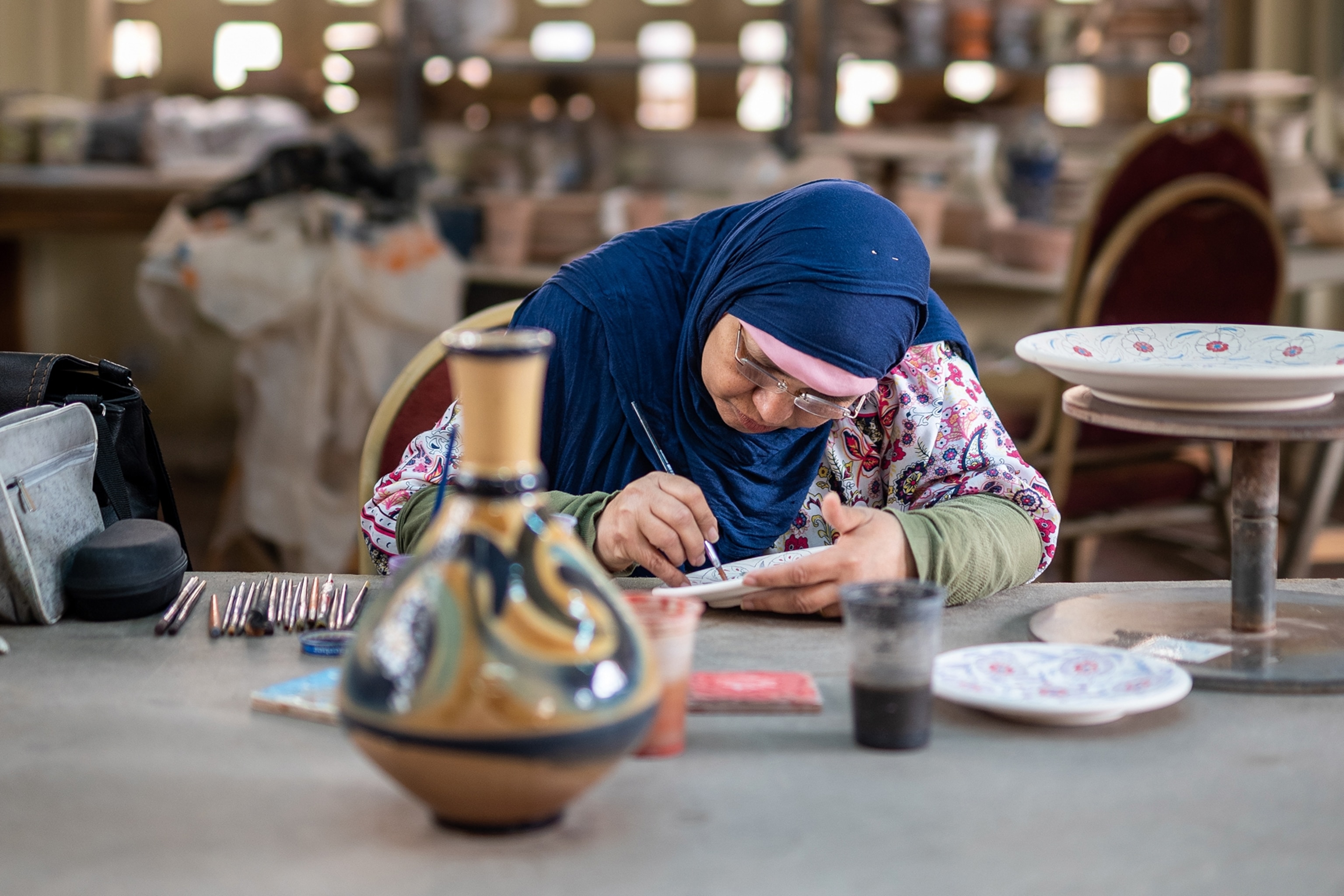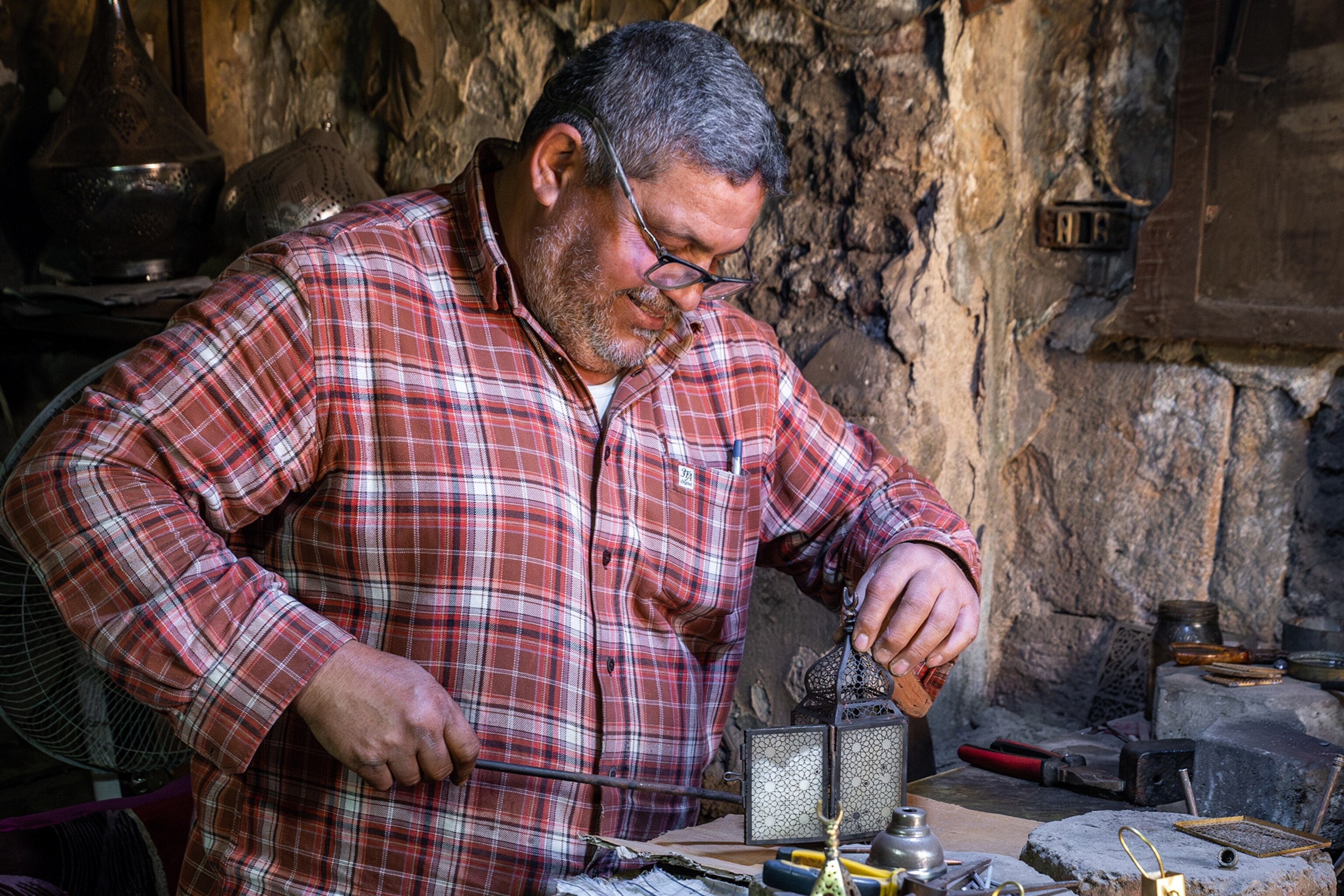
A guide to Cairo's craft heritage, following in the footsteps of ancient artisans
The craft workshops of Cairo tell a story going back to the glory days of medieval Islamic art — a side to the capital easy to overlook with the much-delayed Grand Egyptian Museum opening on the horizon.
In Cairo, the pull between culture and commerce is long established. Five thousand years ago, on the fertile banks of the Nile, wealthy Ancient Egyptians commissioned artisans to adorn their tombs for the voyage into the afterlife, crafting funerary pottery, woodwork, amulets and exquisite paintings. Today, souvenir stalls outside many of those same tombs — and in the souks of the capital — still offer designs that take inspiration from those ancient crafts, passed down over the centuries and adapted to sell to visitors.
Shopping can be a rich and revealing complement to exploring the art and archaeology of Ancient Egypt. In the camel-coloured desert at Saqqara, 14 miles south of the city, I circled Egypt’s first pyramid and watched workmen dressed in flowing jellabiyas cart earth from a recently discovered tomb. I saw wall carvings and paintings of crocodiles and Nile fishermen paddling reed boats, like five-millennia-old film footage. I stood in the subterranean tomb of pharaoh Unas, its stone a blur of hieroglyphic incantations for eternal life, its roof fretted with stars.
And now I find myself in the workshop of Saqqara’s Oriental Carpet School. It wasn’t my idea — is any phrase in Egypt more dispiriting than ‘Now we’ll visit a carpet factory’? But we were passing and my guide, Maher Abu Elkhair, promised it would be interesting.
As workers knot wool and silk threads on looms in one dextrous action, a salesman rattles through the patter: how Saqqara has a tradition of handmade carpets, a craft which flourished in Egypt from the 1400s; how children learn the vocation alongside fathers; how a metre-square is the work of a month. I nod. But I’m not listening: I’ve just seen what’s on one loom.
Master carpet-maker Adem is weaving five-point stars into a kilim. They look naggingly familiar. A beat later I realise why — they’re exactly the same as those at Unas’s tomb. Was this deliberate, I ask. Adem shrugs: “They asked me to make a carpet with stars. I design with stars.” For one beautiful revelatory moment, the threads of ancient and modern Egypt combine, twisting into a perfect cultural knot. Then the salesman says: “We have more upstairs if you want to buy. Something for the memory…”

Later this year, the much-delayed Grand Egyptian Museum is set to open in Giza, on Cairo’s western outskirts. It will house the largest collection of Egyptian antiquities ever assembled: around 140,000 objects. Ancient Egypt’s rock star pharaoh Tutankhamun gets two galleries to himself, uniting all 5,400 artefacts of his tomb for the first time since archaeologist Howard Carter gasped in wonder as he unsealed the door a century ago.
What King Tut’s beaded sandals and gold amulets ultimately showcase is Egyptian craft. It has fascinated Europeans since the Greeks and Romans imported Egyptian gold, ivory and other luxury goods, or Venice struck trade deals with medieval Mamluk sultans for glass and ceramics. Later, Victorian archaeologists gawped in souks. Now it’s my turn. I’ve come to winkle out Cairo’s craft traditions. It’s shopping, but with cultural credentials.
Fustat district doesn’t look like much — it fell into decline as the axis of the city moved north after the 11th century. But it holds some of Christianity’s oldest churches, still serving Egypt’s Coptic community, and the National Museum of Egyptian Civilisation opened here in 2021, showcasing the country’s eras from the pharaohs to the present day. It’s here that Mamdouh Sakr, manager of the Fustat Traditional Crafts Centre, has nurtured crafts in a district once renowned for them.
“For 500 years as the country’s first Islamic capital, Fustat was a very vibrant city because of its Nile port,” he says. “The whole culture of Egypt was exported through here. Excavations have found kilns, glass and ceramics of exceptional quality. The Vatican has more Fatimid-era ceramics than Cairo.”

The crafts centre receives few callers — this is Maher’s first visit here despite decades of guiding — but Mamdouh happily shows me around. Women chat while painting lozenges like teardrops on jugs. A man punches white clay into a mould then peels out a tile of beautiful interlocking stars. Other moulds have webs of hexagons or lotus flowers — all designs from historic Cairene mosques. Because of Islamic traditions that avoided representing living creatures, complex geometry was one art form that came without the risk of straying into idolatry.
Gamal Ahmed Shosha straddles a potter’s wheel. His mother was a potter, and his grandmother and her mother. “I had no choice,” he says, with a grin. Imported white clay is tougher, but soft red clay of Nile silt is better for pottery. “Look,” he says. He presses a metal strip into a spinning bowl. Ribbons of ochre clay spool to the floor. The crude bowl refines into beauty.
The best stuff is in a gallery-shop: flawless marquetry boxes; bead necklaces fit for queens; intricate brass bowls; gypsum panels like cobwebs; and those tiles, now blazing with colour and framed. Such work once decorated the palaces of the elite. It’s part of Egyptian identity, Mamdouh says: “These crafts are unique, like songs and language, and some of the designs are 1,000 years old. But if we don’t support them, it will all be ‘Made in China’.”
The art of the pharaohs is as remote from modern Egypt as the works of ancient Britons are from us. In the absence of a living tradition, it’s all too easy to give way to cheap knock-offs. “We can’t let that happen to Coptic and Islamic art,” says Mamdouh. That’s why the centre, backed by the UK’s Prince’s Foundation, hosts 20 students a year, mostly young women, who train in the old crafts.
Into the souks
Ask Cairo locals about crafts and they’ll point you to Khan el-Khalili souk in the old city. It’s an experience as much as a retail opportunity. If the pyramids conceal their secrets, here all is on show: shisha pipes and silver, telescopes and antique telephones, jewels and junk. You have the sense that, whatever your desire, it lies within these labyrinthine medieval alleys.
I want to do more than buy, though. I want to meet the makers. On Al Moez Street, amid some of the greatest architecture in medieval Islam, Khaled Mohamed delicately hammers the goddess Isis onto a copper disk outside his shop, Al Moez Silver. Behind him hang plates, their kaleidoscopic engraving seeming to whirl as you look. The 51-year-old learned his trade aged 12 from his father, who learned from his father, who learned from a Cairene artisan, until you’re back in a 14th-century golden age under the Mamluk sultans. “This doesn’t require talent if you know the rules — I’m one percent the artist of my father,” Khaled says. “The secret is to love what you do.”
Money problems since the 2011 Egyptian Revolution have closed his engraving school. Yet Khaled’s main problem is us: “Ninety percent of tourists think my plates are made in a factory. They think I do this for show.” You can see why. His work is pure precision.

Al Moez Silver is just the first stop on my crafts treasure hunt through Khan el-Khalili. At the top of narrow stairs in Jordi Passage, I find Achmed Mahmoud soldering gems into a bracelet in a no-name workshop. Bracelets, frames, rings, silver amulets — he’ll hand-produce whatever you want. “I have hundreds of designs,” he says with a wave at shelves of metal weights. He slams one onto paper and its embossed image appears on the sheet — a dove, a template to be hacksawed and polished up within three hours. Such is the skill of a 62-year-old who has worked since he was nine.
I switch to the adjacent Al Azhar quarter. It’s quieter, more local. Among Arabic pop songs jingling from cafes and women with hillocks of flatbread, I stumble upon shoebox workrooms I’m sure I’ll never find again. I meet Bahan and Hesham gluing minute mother-of-pearl triangles onto wooden boxes. It’s easy to dismiss such souvenir favourites until you learn their traditional history as boxes for dowries, or that mother-of-pearl inlay was an Ancient Egyptian trick to prettify poor wood.
Behind Al Azhar mosque, Mohamed ‘Mimi’ Amin shows me 45 years’ worth of expertise casually lying around his workshop; here a beautiful star lantern for Ramadan and a heart-shaped amulet with turquoise “to prevent jealousy”; there, a lamp with kissing peacocks within a thicket of brass. “That design came from an early Coptic chandelier. I’m not rich but these designs are my capital. They’re historic. They have proven their beauty,” he says.

There’s a problem, though. Mimi says foreign visitors expect bargains in Egypt. Few stump up for skilled work, so shopkeepers prefer factory-made tat. That’s bad news for Mimi, and for his young son, smiling shyly from a workbench. I recall how Bahan said cheap boxes used plastic inlay instead of mother of pearl. Also, how Achmed had advised his son to seek another profession after five years’ training. He moved into computers instead. Mimi glances around his workshop; at hand-drills and hacksaws and off-cuts of brass. “We have no machine here yet, alhamdulillah (praise be to God).”
The Grand Egyptian Museum arrives freighted with huge aspirations. There’s big talk about how it can make Egypt proud again. I’m sure it will. But I also wonder whether our fascination with the dead history of the pharaohs blinds us to a living one. Whether we shouldn’t be just as fascinated by people like Mimi, quietly continuing the craft of centuries in the backstreets of Cairo.
Steppes Travel offers an 11-day Egypt package including three nights in Cairo, staying in Marriott Mena House, with expert guides and private transfers for £6,025 per person, excluding flights. It also includes a Nile cruise plus two nights in Aswan.
This story was created with the support of the Egypt Tourist Authority.
To subscribe to National Geographic Traveller (UK) magazine click here. (Available in select countries only).
You May Also Like
Go Further
Animals
- How scientists are piecing together a sperm whale ‘alphabet’How scientists are piecing together a sperm whale ‘alphabet’
- Orangutan seen using plants to heal wound for first timeOrangutan seen using plants to heal wound for first time
- What La Palma's 'lava tubes' tell us about life on other planetsWhat La Palma's 'lava tubes' tell us about life on other planets
- This fungus turns cicadas into zombies who procreate—then dieThis fungus turns cicadas into zombies who procreate—then die
Environment
- This floating flower is beautiful—but it's wreaking havoc on NigeriaThis floating flower is beautiful—but it's wreaking havoc on Nigeria
- What the Aral Sea might teach us about life after disasterWhat the Aral Sea might teach us about life after disaster
- What La Palma's 'lava tubes' tell us about life on other planetsWhat La Palma's 'lava tubes' tell us about life on other planets
- How fungi form ‘fairy rings’ and inspire superstitionsHow fungi form ‘fairy rings’ and inspire superstitions
- Your favorite foods may not taste the same in the future. Here's why.Your favorite foods may not taste the same in the future. Here's why.
- Are the Great Lakes the key to solving America’s emissions conundrum?Are the Great Lakes the key to solving America’s emissions conundrum?
History & Culture
- These were the real rules of courtship in the ‘Bridgerton’ eraThese were the real rules of courtship in the ‘Bridgerton’ era
- A short history of the Met Gala and its iconic looksA short history of the Met Gala and its iconic looks
- Meet the ruthless king who unified the Kingdom of Hawai'iMeet the ruthless king who unified the Kingdom of Hawai'i
- Hawaii's Lei Day is about so much more than flowersHawaii's Lei Day is about so much more than flowers
Science
- Why ovaries are so crucial to women’s health and longevityWhy ovaries are so crucial to women’s health and longevity
- Orangutan seen using plants to heal wound for first timeOrangutan seen using plants to heal wound for first time
Travel
- Why this unlikely UK destination should be on your radarWhy this unlikely UK destination should be on your radar






